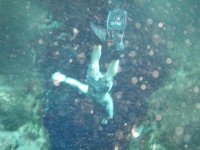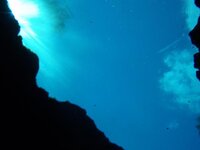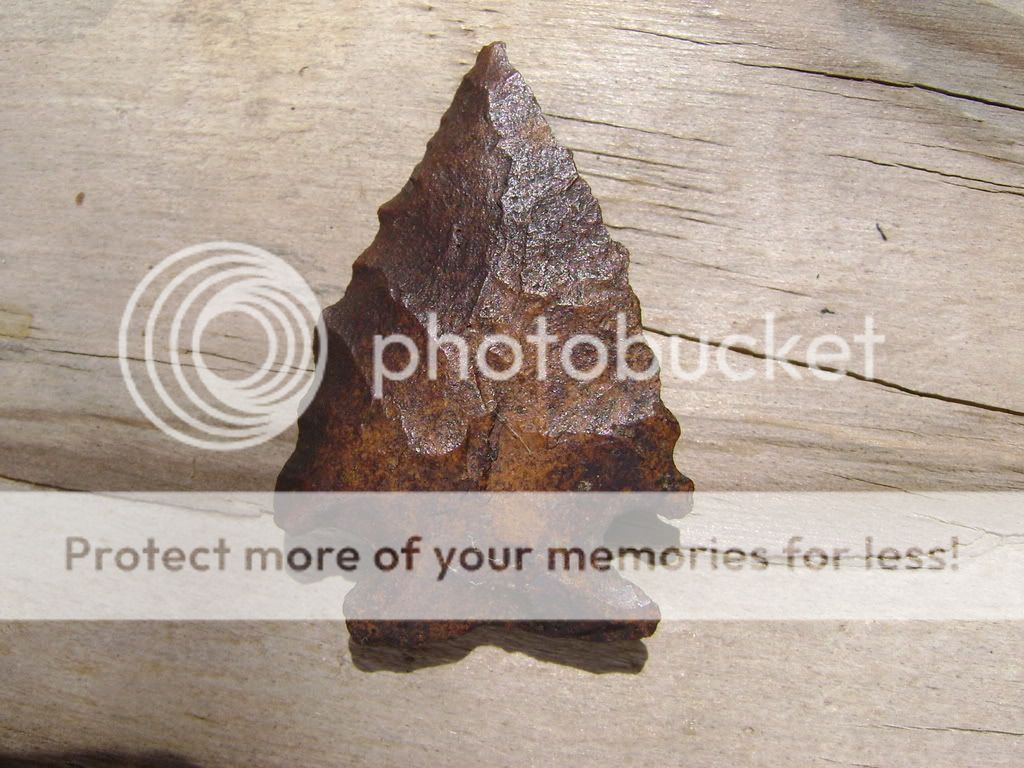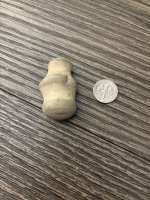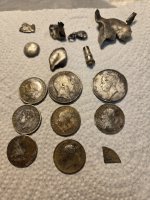You are using an out of date browser. It may not display this or other websites correctly.
You should upgrade or use an alternative browser.
You should upgrade or use an alternative browser.
Nasty Bolen
- Thread starter tomclark
- Start date
Hill Billy
Bronze Member
- Jun 3, 2007
- 1,766
- 76
- Detector(s) used
- Whites XLT
- Primary Interest:
- Other
Think that one would hurt?  Nice find
Nice find
 Nice find
Nice find
P
pickaway
Guest
Nice... 

StevefromMissouri
Sr. Member
I thought the whole artifact was chipped! lol!!
Steve
Steve
Airborne80
Bronze Member
- Mar 23, 2005
- 1,020
- 6
- Detector(s) used
-
Whites XLT Classic
Teknetics Delta 4000
- Primary Interest:
- All Treasure Hunting
Outstanding!!!
recoiljunky
Jr. Member
Cool looking bolen.
lamplighter36
Full Member
i think it's a beauty. chipped base and all. i was in the itch last weekend. i always look for things (not that i would remove anything from a state park. i assume you were south of the state land. anyways, what a fine bolen.
i have a scraper i found years ago in the santa fe. i'll post a pic if you are interested.
not to de-rail the topic but here's a pic from within the itch's blue hole looking up. i pride myself in being able to get down to the sand in one breath.
btw- is that bolen beveled at all?
let me know if you ever need a dive buddy.
-thomas
i have a scraper i found years ago in the santa fe. i'll post a pic if you are interested.
not to de-rail the topic but here's a pic from within the itch's blue hole looking up. i pride myself in being able to get down to the sand in one breath.
btw- is that bolen beveled at all?
let me know if you ever need a dive buddy.
-thomas
Attachments
tomclark
Bronze Member
- Dec 18, 2006
- 1,177
- 1,641
- Detector(s) used
- ShadowX2, TEJON, Eyes, Pony Shovel
- Primary Interest:
- Other
- Thread starter
- #8
Lamplighter, I have an almost exact picture of myself and the "Hole"! LOL. Back in the day I'd put in at the top and snorkel the entire run in the State Park, never getting into a tube and wearing a "light" weight belt. The point was found a few hundred feet downstream from the bridge in front of a friend's dock. I found a large antler point right up next to the bridge.
That river has become one of the most beautiful I've ever been in or seen - again. At one time the bottom was littered with trash, especially cans and bottles, until the state took it over. Now it is almost pristine.
Here's a point from the Santa Fe just upstream from Rum Island. One of the last legal, reported points found in any FL river just before the abolishment of the Isolated Finds Program. It is illegal to pick up isolated finds over 50 years old, including bottles, coins, points, etc. from FL state waters at this time, except for the Peace River, LOL. Make no bones about it, their agenda is to make collecting of anything illegal. Some archies supported the IFP and amateur collecting but the rest of 'em and the state suck.

That river has become one of the most beautiful I've ever been in or seen - again. At one time the bottom was littered with trash, especially cans and bottles, until the state took it over. Now it is almost pristine.
Here's a point from the Santa Fe just upstream from Rum Island. One of the last legal, reported points found in any FL river just before the abolishment of the Isolated Finds Program. It is illegal to pick up isolated finds over 50 years old, including bottles, coins, points, etc. from FL state waters at this time, except for the Peace River, LOL. Make no bones about it, their agenda is to make collecting of anything illegal. Some archies supported the IFP and amateur collecting but the rest of 'em and the state suck.

pynchinflint
Jr. Member
Kinda makes me wonder if it will be illegal to pick up that Stanley screwdriver I dropped in the lake or that Craftsman hammer that I lost in a couple of hundred years from now. 
Very nice points you have Tom and thanks for showing!

Very nice points you have Tom and thanks for showing!
recoiljunky
Jr. Member
creekhunter
Bronze Member
- Dec 14, 2007
- 1,237
- 572
- Detector(s) used
- Radio Shack
- Primary Interest:
- All Treasure Hunting
Sweet show! Any Idea what Ichetucknee means in the native tongue? 
tomclark
Bronze Member
- Dec 18, 2006
- 1,177
- 1,641
- Detector(s) used
- ShadowX2, TEJON, Eyes, Pony Shovel
- Primary Interest:
- Other
- Thread starter
- #13
From Wikipedia
"The Ichetucknee River is a spring fed, pristine river in north central Florida. Thousands of people visit the river and springs each year. Activities include hiking, wildlife viewing, picnicking, swimming, tubing, canoeing, snorkeling and cave diving (scuba). The entire 6 miles (9.7 km) of the river average 20 feet (6.1 m) wide, 5 feet (1.5 m) deep and lie within the boundaries of the Ichetucknee Springs State Park.
The name is derived from a Native American language, possibly Creek wa (water), echas (beaver), and toka or tomeka (because of, or caused by), meaning "beaver pond" (beaver remains are common in the riverbed). A Hitchiti informant to anthropologist John R. Swanton pronounced the name "Oetcotukni", and translated it as "where there is a pond of water", likely referring to a defunct beaver pond.
The water in the river is crystal-clear and is 72 °F (22 °C) year-round. There are nine named springs within the Ichetucknee Springs group with an average total flow of 233 million gallons per day. The group includes: Ichetucknee Springs, Cedar Head Spring, Blue Hole Spring, Roaring Springs, Singing Springs, Boiling Spring, Grassy Hole Springs, Mill Pond Spring, and Coffee Spring. The Ichetucknee is a tributary of the Santa Fe River, which in turn flows into the Suwannee River before emptying into the Gulf of Mexico. The park restricts launch and end points along the river, permitting a tube/raft excursion of 1.5 or 3 hours. A variety of commercial vendors, located outside the entrance to the park, rent tubes and rafts for a modest fee.
Park wildlife includes: Otter, beaver, turtle, ibis, wood stork, egret, great blue heron, cormorant, anhinga, kingfisher, limpkin, wild turkey, wood duck, white-tailed deer, raccoon, armadillo, water snakes and juvenile alligators. The fish are primarily bream, bluegill, largemouth bass, alligator gar, mullet and catfish. Manatees have been seen in the winter months.
History
The river and springs were used consistently by early cultures of Native Americans, dating back thousands of years. Teeth and bones of mastodon and other extinct megafauna have been found in the river. A 17th century Spanish mission site has been identified in the park, next to a short tributary connecting Fig Springs to the Ichetucknee River, about one mile (1.6 km) downstream from the headspring of the river. San Martín de Timucua, built in 1608, was one of the major interior missions serving the important Spanish settlement of St. Augustine and flourished through most of that century. Plans to reconstruct the mission and open it to the public as an interpretational site were dropped.
The Seminole Wars of the early to mid-1800s drove those natives from north Florida. In the late 1800s, William Henry Collins owned the Mill Pond store and Gristmill on the Ichetucknee to grind corn into cornmeal and grits for the booming population of nearby Fort White, Florida. For a short while Ichetucknee even had a post office at the Mill Pond store. With the gradual decline of Fort White between 1895 and the first world war, the population of Fort White plunged from 2000 to several hundred, resulting in the closure of the mill and store.
The locals have always known of and enjoyed the Ichetucknee River & Springs. It was the perfect place to cool off at the end of a long, hot day in the fields. However, before 1970, the existence and location of this natural wonder were something of a secret, known only to local residents. The road to the spring was not paved, nor was it marked. The spring was on private property and the owners mostly ignored it. During the late 1960s, the area was overrun with students from the nearby University of Florida. [3] Food wrappers and drink containers littered the area because there were no trash receptacles and no garbage pickup. Broken glass was occasionally found on the rocks and in the water. After a swimmer was injured, the absentee property owners threatened to fence the area and curtail public access. Loncala looked for an opportunity to find an “ecologically minded” buyer.
The State takes control
The State of Florida purchased the property from the Loncala Phosphate Corporation in 1970 for $1,850,000 and a much needed cleanup took place. The springs became a state park, and Columbia County built a paved road, number 238, for easier access. In 1972, the head spring of the river was declared a National Natural Landmark by the U. S. Department of the Interior. Now everybody knew about Ichetucknee. The main tributary flowing from Ichetucknee Springs soon became the most popular tubing river in the world, attracting over five thousand people daily during the peak summer months. Hundreds of others came to swim and picnic at the headspring, scuba dive in the caves of the famous "blue hole", and walk the nature trails that wind through the park's hammocks and longleaf pine forests. [1] Not surprisingly, it wasn't long before Ichetucknee Springs began showing the obvious signs of over-use. Underwater plants were uprooted, wildlife disappeared, and bank erosion increased. To rectify these problems, the Park Service implemented a "carrying capacity", limiting the number of people on the river at any one time. The effect on the spring ecosystem was both positive and immediate. Vegetation began to reappear, wildlife returned, and the turbidity disappeared. To curb littering, the Park Service prohibited food, drinks and tobacco on the river, which has helped return the area to a natural, pristine beauty.
Current Threats:
In the early 1990s, the springs were showing signs of an even more disturbing degradation: a progressive decline in water quality. The Florida Department of Environmental Protection commissioned studies which showed that nutrient levels were steadily increasing. Additionally, some swimmers and tubers began to report strange skin rashes, possibly caused by algae fed by nutrients introduced into the aquifer. "
Lots of pics of it on Google Image search
"The Ichetucknee River is a spring fed, pristine river in north central Florida. Thousands of people visit the river and springs each year. Activities include hiking, wildlife viewing, picnicking, swimming, tubing, canoeing, snorkeling and cave diving (scuba). The entire 6 miles (9.7 km) of the river average 20 feet (6.1 m) wide, 5 feet (1.5 m) deep and lie within the boundaries of the Ichetucknee Springs State Park.
The name is derived from a Native American language, possibly Creek wa (water), echas (beaver), and toka or tomeka (because of, or caused by), meaning "beaver pond" (beaver remains are common in the riverbed). A Hitchiti informant to anthropologist John R. Swanton pronounced the name "Oetcotukni", and translated it as "where there is a pond of water", likely referring to a defunct beaver pond.
The water in the river is crystal-clear and is 72 °F (22 °C) year-round. There are nine named springs within the Ichetucknee Springs group with an average total flow of 233 million gallons per day. The group includes: Ichetucknee Springs, Cedar Head Spring, Blue Hole Spring, Roaring Springs, Singing Springs, Boiling Spring, Grassy Hole Springs, Mill Pond Spring, and Coffee Spring. The Ichetucknee is a tributary of the Santa Fe River, which in turn flows into the Suwannee River before emptying into the Gulf of Mexico. The park restricts launch and end points along the river, permitting a tube/raft excursion of 1.5 or 3 hours. A variety of commercial vendors, located outside the entrance to the park, rent tubes and rafts for a modest fee.
Park wildlife includes: Otter, beaver, turtle, ibis, wood stork, egret, great blue heron, cormorant, anhinga, kingfisher, limpkin, wild turkey, wood duck, white-tailed deer, raccoon, armadillo, water snakes and juvenile alligators. The fish are primarily bream, bluegill, largemouth bass, alligator gar, mullet and catfish. Manatees have been seen in the winter months.
History
The river and springs were used consistently by early cultures of Native Americans, dating back thousands of years. Teeth and bones of mastodon and other extinct megafauna have been found in the river. A 17th century Spanish mission site has been identified in the park, next to a short tributary connecting Fig Springs to the Ichetucknee River, about one mile (1.6 km) downstream from the headspring of the river. San Martín de Timucua, built in 1608, was one of the major interior missions serving the important Spanish settlement of St. Augustine and flourished through most of that century. Plans to reconstruct the mission and open it to the public as an interpretational site were dropped.
The Seminole Wars of the early to mid-1800s drove those natives from north Florida. In the late 1800s, William Henry Collins owned the Mill Pond store and Gristmill on the Ichetucknee to grind corn into cornmeal and grits for the booming population of nearby Fort White, Florida. For a short while Ichetucknee even had a post office at the Mill Pond store. With the gradual decline of Fort White between 1895 and the first world war, the population of Fort White plunged from 2000 to several hundred, resulting in the closure of the mill and store.
The locals have always known of and enjoyed the Ichetucknee River & Springs. It was the perfect place to cool off at the end of a long, hot day in the fields. However, before 1970, the existence and location of this natural wonder were something of a secret, known only to local residents. The road to the spring was not paved, nor was it marked. The spring was on private property and the owners mostly ignored it. During the late 1960s, the area was overrun with students from the nearby University of Florida. [3] Food wrappers and drink containers littered the area because there were no trash receptacles and no garbage pickup. Broken glass was occasionally found on the rocks and in the water. After a swimmer was injured, the absentee property owners threatened to fence the area and curtail public access. Loncala looked for an opportunity to find an “ecologically minded” buyer.
The State takes control
The State of Florida purchased the property from the Loncala Phosphate Corporation in 1970 for $1,850,000 and a much needed cleanup took place. The springs became a state park, and Columbia County built a paved road, number 238, for easier access. In 1972, the head spring of the river was declared a National Natural Landmark by the U. S. Department of the Interior. Now everybody knew about Ichetucknee. The main tributary flowing from Ichetucknee Springs soon became the most popular tubing river in the world, attracting over five thousand people daily during the peak summer months. Hundreds of others came to swim and picnic at the headspring, scuba dive in the caves of the famous "blue hole", and walk the nature trails that wind through the park's hammocks and longleaf pine forests. [1] Not surprisingly, it wasn't long before Ichetucknee Springs began showing the obvious signs of over-use. Underwater plants were uprooted, wildlife disappeared, and bank erosion increased. To rectify these problems, the Park Service implemented a "carrying capacity", limiting the number of people on the river at any one time. The effect on the spring ecosystem was both positive and immediate. Vegetation began to reappear, wildlife returned, and the turbidity disappeared. To curb littering, the Park Service prohibited food, drinks and tobacco on the river, which has helped return the area to a natural, pristine beauty.
Current Threats:
In the early 1990s, the springs were showing signs of an even more disturbing degradation: a progressive decline in water quality. The Florida Department of Environmental Protection commissioned studies which showed that nutrient levels were steadily increasing. Additionally, some swimmers and tubers began to report strange skin rashes, possibly caused by algae fed by nutrients introduced into the aquifer. "
Lots of pics of it on Google Image search
creekhunter
Bronze Member
- Dec 14, 2007
- 1,237
- 572
- Detector(s) used
- Radio Shack
- Primary Interest:
- All Treasure Hunting
Great Post! 

Users who are viewing this thread
Total: 2 (members: 0, guests: 2)




